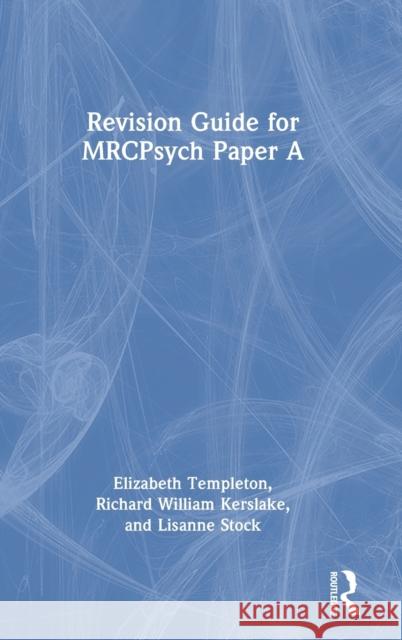Revision Guide for MRCPsych Paper A » książka



Revision Guide for MRCPsych Paper A
ISBN-13: 9780815363897 / Angielski / Twarda / 2022 / 184 str.
Revision Guide for MRCPsych Paper A
ISBN-13: 9780815363897 / Angielski / Twarda / 2022 / 184 str.
(netto: 627,14 VAT: 5%)
Najniższa cena z 30 dni: 651,77
ok. 22 dni roboczych.
Darmowa dostawa!
This study guide covers the key information necessary to pass Paper A of the postgraduate examination to become a member of the Royal College of Psychiatrists (MRCPsych).
PART I: Behavioural Sciences and Sociocultural Psychiatry; 1 Fundamentals of Psychology; a) Conditioning; b) Shaping and Chaining; c) Social Learning Theory; d) Perceptual Organisation; e) Theories of Perception; f) Memory; g) Retrieval; h) Ribot’s Law; i) Memory Disorders; j) Memory Neuroscience; k) Brain Structures Involved in Memory; 2 Basic and Social Psychology; a) Personality; b) Emotion; c) Motivation; d) Attitudes; e) Intelligence; f) Cognitive Dissonance (Leon Festinger); g) Self-Psychology; h) Attribution; i) Theory of Mind; j) Controversial Studies; k) Groups and Conforming; l) Consent in Minors; 3 Sociocultural Psychiatry; a) Ethics; b) Global Ethical Policies; c) Human Rights; d) Models of Illness; e) Family Life; f) Theory of Expressed Emotion (EE); g) Society and Mental Health; h) History of Major Publications in Psychiatry; i) Important Figures in Psychiatry; j) Immigration and Schizophrenia; k) Stigma; l) Grief; PART II: Human Development; 4 Theories of Human Development; a) Piaget’s Theory of Cognitive Development; b) The Zone of Proximal Development; c) Kohlberg’s Theory of Moral Development; d) Freud’s Stages of Psychosexual Development (1905); e) Erikson’s Stages of Psychosocial Development; f) Mahler’s ‘Separation-Individuation’ Stages of Child Development (1968); g) Table of Relevant Developmental Stages; h) Temperament; i) Fear; j) Speech/Language Milestones; k) Motor Milestones; l) Attachment Theory; m) Studies Related to Attachment; n) Mary Ainsworth (1973); o) Developmental Concepts; p) Parenting Styles; q) Freudian Concepts; r) Assessment of Intelligence; PART III: Basic Neurosciences; 5 Neuroanatomy; a) Brain Development; b) Cranial Fossae; c) Meningeal Layers; d) Cortical Structures; f) Cranial Foramina; g) Subcortical Structures; h) Thalamus; i) Cerebellum; j) Brain Stem and Cranial Nerves; k) White Matter Pathways; l) Spinal Cord; m) Cerebrospinal Fluid (CSF); n) Blood Supply; o) Blood-Brain Barrier (BBB); 6 Neurophysiology; a) The Action Potential; b) The Hypothalamic-Pituitary-Adrenal Axis (HPA); c) Adrenal Fatigue; d) Thyroid Gland; e) Adrenal Cortex; f) Dexamethasone Suppression Tests (DSTs); g) Tremors; h) Electroencephalograms (EEG); i) Sleep Architecture; j) Sleep Disorders; 7 Neurochemistry; a) Classification of Receptors; b) Biogenic Amines; c) Catecholamines; d) Monoamine Oxidase (MAO); e) Acetylcholine; 8 Molecular Genetics; a) DNA; b) RNA; c) Copying DNA; d) DNA Mutations; e) Translocations; f) Terminology; g) Mendelian Inheritance ; h) Non-Mendelian Inheritance; i) Techniques in Molecular Genetics; j) Heritability; k) Concordance; l) Hardy–Weinberg Equilibrium; m) Genetic Studies; n) Schizophrenia Genetics; o) Affective Disorders Genetics; p) Autism Genetics; q) Attention-Deficit/Hyperactivity Disorder (ADHD) Genetics; r) Summary of Genetic Disorders; 9 Clinical Neuropathology; a) Alzheimer’s Disease (AD); b) Lewy Body Dementia (LBD); c) Frontotemporal Dementia (FTD); d) Creutzfeldt-Jakob Disease (CJD); e) Schizophrenia; f) Parkinson’s Disease; g) Summary of Pathological Findings; 10 Applied Neurosciences; a) Frontal Lobe; b) Parietal Lobe; c) Temporal Lobe Lesions; d) Apraxia; e) Language; f) Agnosia; PART IV: Clinical Psychopharmacology; 11 Mechanisms of Psychotropic Drugs; a) Classification of Psychotropic Medications; b) Typical Antipsychotics; d) Antidepressants; e) Anxiolytics and Sedatives; f) Antiepileptics and Mood Stabilisers; g) Dementia Drugs; h) ADHD Drugs; i) Drugs Used in the Treatment of Substance Misuse; j) Recreational Drugs; 12 Specifics of Prescribing; a) Rational Prescribing; b) Drugs With Psychiatric Side Effects; c) Side Effects of Antidepressants; d) Antidepressant Withdrawal; e) Side Effects of Antipsychotics; f) Metabolic Side Effects of Antipsychotics; g) Antipsychotic Associated Hyperprolactinaemia; h) Drug Doses; i) Neuroleptic Malignant Syndrome and Serotonin Syndrome; j) Allergies and Toxicity; k) Specialist Drug Monitoring; l) Prescribing in Special Groups; m) Prescribing in Pregnancy and Breastfeeding; n) Principles in Psychiatric Emergencies; o) Driving; p) Electroconvulsive Therapy (ECT); q) Factors Affecting Medication Adherence; r) The Placebo Effect; 13 Pharmacokinetics; a) Key Aspects; b) Absorption; c) Distribution; d) Metabolism; e) Excretion; 14 Broader Aspects of Psychopharmacology; a) Clinical Trials; b) Adverse Event Reporting; PART V: Classification and Assessment; 15 Classification; a) Diagnostic Manuals; b) Changes From DSM-IV to DSM-5; c) Approaches to Classification; 16 History and Mental State Examination; a) The Psychiatric History; b) Cognitive Function; c) The Neurological Examination; d) Blood Investigations; e) Specialist Dementia Scans; f) Delirium; g) Eating Disorders; h) Treatment With Comorbid HIV Infection; i) Intelligence Quotient (IQ); j) Assessment Scales; 17 Psychopathology; a) Thought Disorders; b) Classifying Thought Form; c) Explanatory Models; d) Classifying Thought Content; e) Disorders of Speech; f) Disorders of Memory; g) Disorders of Mood and Affect; h) Disorders of Perception; 18 Diagnosis and ICD-10 Classification Codes; a) ICD-10 vs. DSM-IV 198; b) F00—F09 Organic, Including Symptomatic, Mental Disorders; c) F10—F19 Mental and Behavioural Disorders Due to Psychoactive Substance Use; d) F20—F29 Schizophrenia, Schizotypal and Delusional Disorder; e) F30—F39 Mood (Affective) Disorders; f) F40—F49 Neurotic, Stress-Related and Somatoform Disorders; g) F50—F59 Behavioural Syndromes Associated With Physiological Disturbances and Physical Factors; h) F60—F69 Disorders of Adult Personality and Behaviour
1997-2026 DolnySlask.com Agencja Internetowa
KrainaKsiazek.PL - Księgarnia Internetowa









